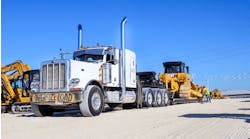A revision to the Federal Excise Tax that is levied on over-the-road tires is now finalized and scheduled to be effective with tires sold on or after January 1, 2005. Historically, this tax has been assigned to specific brands and models of tires based on new tire weight. All tires weighing under 40 lb. were tax-free. In practical terms, this exempted nearly all passenger car and light truck tires up through those commonly applied to nominal half-ton pickup trucks, and most highway tire designs for 3/4 ton models. The new tax maintains this general distinction between consumer and commercial vehicle tires by exempting tires having a load capacity of 3500 lb. or less.
Because the current tax was weight-based, it resulted in some assigned values that had poor correlation to the level of highway wear and tear — for which the tax was presumably designed to compensate. This was due to differences in tread depth and pattern design and did not necessarily relate to the tread life expectancy or the total weight carrying capacity of the tire/wheel assemblies
The new tax is assigned based on tire load carrying capacity (LCC) and applies only to LCC in excess of 3500 lb. Similar to the old tax, it applies to tires that are both used on “Highway Vehicles” and are marked in accordance with federal regulations for highway use. The tax rate for radial tires is 9.45 cents per 10 lb. of LCC in excess of 3500 lb. A sample calculation for the industry's most popular size, the 295/75R22.5 Load Range G, having a rated LCC of 6175 lb. would be as follows:
Since this rate applies universally to all tires having the same rated load capacity, all steer, drive, and trailer tires of this size and load range will be taxed at this value.
Overall, the new tax has been designed to be revenue-neutral compared to the older version, but there are some twists fleets should be aware of.
Referring to the tires designed for different axle positions noted above, taxes for steer tires generally will increase moderately, while drive tire taxes will be reduced by a greater value. Shallow tread trailer tire taxes will be raised substantially in virtually all cases.
Taxes on smaller diameter high-load capacity tires, including some higher load range versions will also tend to increase.
One other aspect of the new tax is to provide a reduced rate (4.725 cents per 10 lb. of LCC in excess of 3500 lb.) for two specific tire types.
The first is bias ply tires, presumably based on their reduced tread life expectancy and the fact they are now practically a niche application.
The second tire grouping to benefit from the reduced tax rate is wide-base single tires, defined as those tires having a cross section width of greater than 13 in. and designed to replace two tires in dual fitment applications. This favorable tax treatment alone could be enough to change significantly the cost/benefit relationship when deciding whether or not to apply these tires in place of conventional-sized dual tire assemblies.
In sum, the new tire tax appears to be more logical and simple compared to the method it replaces. The dollar consequences can range from significant to merely a tradeoff, depending on the specific brands and models of tires you are using.
As always, facts trump opinion and rumor, so savvy fleet operators should consult their tire suppliers to determine the specifics for their situation.


